Are Irish And European Butter The Same?
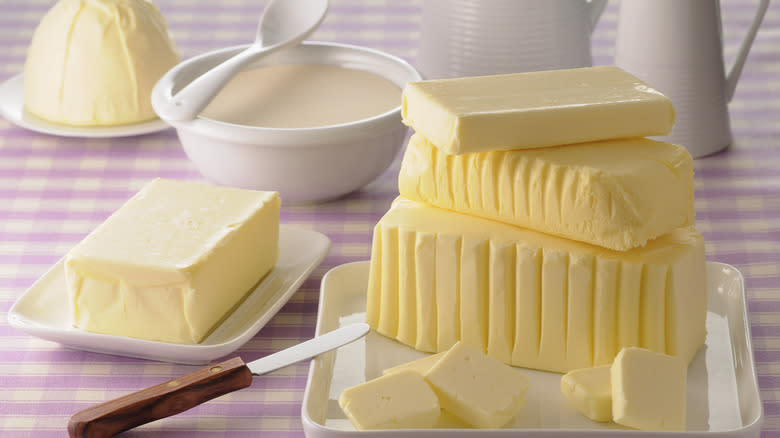
In the wonderful world of butter, European butter reigns supreme. There are lots of good kinds of butter out there, but European butter consistently sits at the top end in terms of flavor and texture. But Europe is a big place and there are differences between European butters, too. Take Ireland for example. Irish butter is without a doubt some of the best butter money can buy. Kerrygold is the most popular Irish butter brand in the United States. It's so popular, in fact, that it's the second best selling butter in the country behind Land O'Lakes.
So what is the difference? Ireland is a part of Europe, which means that technically speaking, Irish butter is European butter. That said, there is enough that Ireland does differently that it warrants its own category. From how it's made to the nutritional composition, Irish butter is truly in a league of its own.
Read more: 12 Popular Grocery Store Butter Brands, Ranked
What Is European Butter?
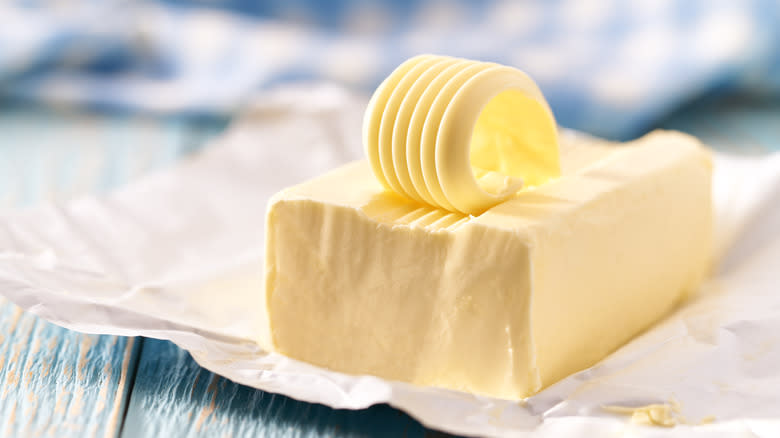
When comparing different kinds of butter to each other, we usually look at the butterfat content and what the cows eat. European butter differentiates itself from other kinds of butter because it has a butterfat content of 82% minimum, with some brands even going as high as 90%. This relatively higher butterfat content makes European butter better in many types of baked goods since the ratio of butterfat to water has a major impact on how baked goods turn out. For example, a high butterfat content is responsible for light and fluffy croissants.
European-style butter is a term often used interchangeably with cultured butter, since most European butter is cultured, which we'll eventually dive into. European butter is known for its soft, velvet-smooth texture and rich, tangy flavors that are sometimes referred to as tasting more lactic. Delicious over a piece of toast or a baguette, European butter is also great as a cooking ingredient when you want the flavor of the butter to shine.
What Is Irish Butter?

At a very broad level, Irish butter is any butter made in Ireland. But there are traditions and characteristics common to the country that differentiate it from other kinds of European butter. Irish butter comes in at 82% butterfat content at a minimum, just like every other European butter, but differs from European products in that it's grass-fed and often both uncultured and salted.
Ireland is full of lush green grass thanks to their wet climate and Irish dairy cows are predominantly grass-fed with fresh grass straight from the Earth — though their diet may be supplemented during the cold winter months. Moreover, what the cows are fed has a huge impact on how the butter tastes. The high fat content gives Irish butter its rich creaminess and its flavor is often described as bright and grassy.
If the cows are enjoying a diet that is nutritionally balanced that means there's a good mixture of fatty acids and vitamins going into the butter. If the nutritional composition of the butter is off due to a poor diet, the quality of the butter will suffer. Ireland's fresh fields of green grass are a great source of nutrition, and the proof is in the butter. One notable benefit is the presence of polyunsaturated fats in grass-fed butter which, apart from its health benefits, makes the butter easier to spread.
Beta-Carotene For The Win
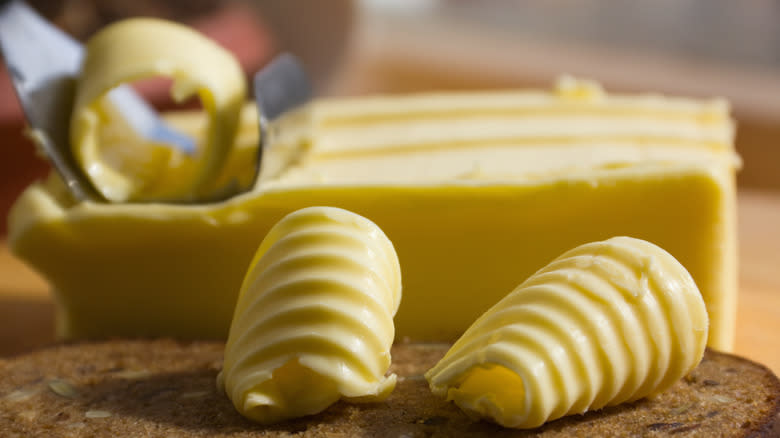
Speaking of Ireland's green grass, it's a great source of beta-carotene. Beta-carotene is the chemical compound responsible for the rich yellow tinge Irish butter is known for. The soft yellow color is considered a good visual indicator of quality butter — so much so that dairy companies that don't have grass-fed butter rich in beta-carotene will add food coloring to imitate it.
Europe's dairy cows aren't all fed one standard diet; each farm is going to have their own preferences. That said, Ireland's grasslands are not ubiquitous to the continent and most European butter doesn't have the luxury of an entirely grass-fed dairy industry rich in beta-carotene. Europe's other primary dairy producing countries are Germany, France, Poland, the Netherlands, and Italy. The northern region of the Netherlands does have a similar climate to Ireland, rich in fertile grasslands — but in other regions soy, rice bran, and corn make up a significant portion of the cows' diet.
Culture And Uncultured
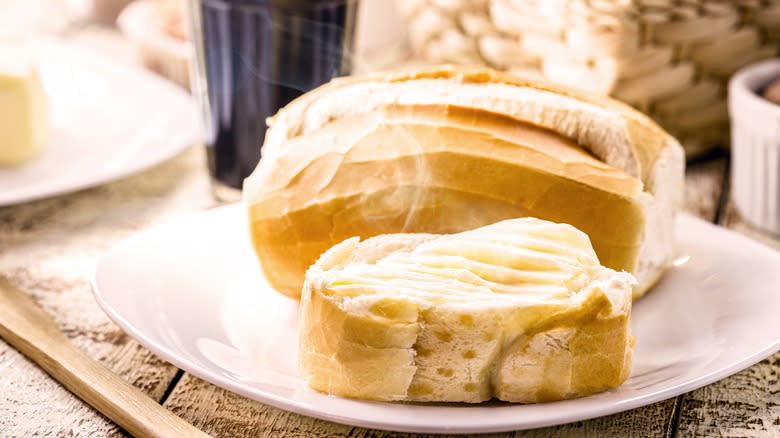
As was previously mentioned, European butter is practically synonymous with cultured butter. Cultured butter has been exposed to harmless lactic bacteria in much the same way as yogurt or sour cream. After the milk has spent 16 to 24 hours with the bacteria it's called crème fraiche. The crème fraiche is then churned in the same way that uncultured milk is to produce butter. The result is a tangy, lactic flavor that differentiates itself from uncultured butter, which can taste sweet or even bland (uncultured butter is also known as sweet cream butter).
Irish butter is not normally cultured. The flavors from a good, fresh diet provide enough complexity in flavor to not need it. If Irish butter were cultured, the fermentation process would likely interfere with the already delicious flavor Irish butter is known for. Apart from flavor, cultured butter is more acidic which gives it a longer shelf life.
Staying Salty
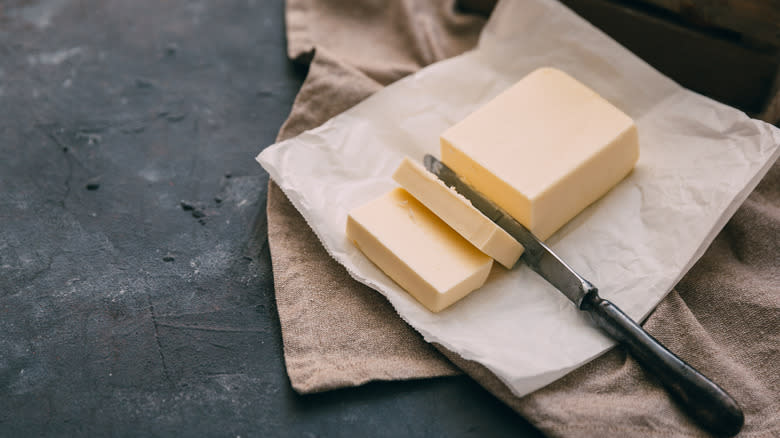
Irish butter also differentiates itself from European butter by adding salt. On a practical level, salt extends the shelf life of the butter. The inclusion of salt also has an impact on flavor and should be taken into consideration when you're cooking with butter, since it can impact the dish. Most recipes will explicitly state if you need salted or unsalted butter. It's particularly important in baked goods, where the chemical interactions of all the ingredients play an important role in how the dish turns out and even a small increase in the amount of salt can throw a tin of muffins completely off. Because of this, unsalted European butter is preferred for baked goods.
If you want to make a delicious sauce or cook a piece of steak with butter, salted butter can elevate the flavors in a way unsalted butter isn't capable of. It's also great as a spread since it comes packed with flavor. You can find both salted and unsalted versions of both Irish and European butter, but these are the general trends.
Read the original article on Tasting Table.

